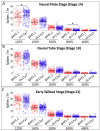Calcium Activity Dynamics Correlate with Neuronal Phenotype at a Single Cell Level and in a Threshold-Dependent Manner
- PMID: 30995769
- PMCID: PMC6515432
- DOI: 10.3390/ijms20081880
Calcium Activity Dynamics Correlate with Neuronal Phenotype at a Single Cell Level and in a Threshold-Dependent Manner
Abstract
Calcium is a ubiquitous signaling molecule that plays a vital role in many physiological processes. Recent work has shown that calcium activity is especially critical in vertebrate neural development. Here, we investigated if calcium activity and neuronal phenotype are correlated only on a population level or on the level of single cells. Using Xenopus primary cell culture in which individual cells can be unambiguously identified and associated with a molecular phenotype, we correlated calcium activity with neuronal phenotype on the single-cell level. This analysis revealed that, at the neural plate stage, a high frequency of low-amplitude spiking activity correlates with an excitatory, glutamatergic phenotype, while high-amplitude spiking activity correlates with an inhibitory, GABAergic phenotype. Surprisingly, we also found that high-frequency, low-amplitude spiking activity correlates with neural progenitor cells and that differentiating cells exhibit higher spike amplitude. Additional methods of analysis suggested that differentiating marker tubb2b-expressing cells exhibit relatively persistent and predictable calcium activity compared to the irregular activity of neural progenitor cells. Our study highlights the value of using a range of thresholds for analyzing calcium activity data and underscores the importance of employing multiple methods to characterize the often irregular, complex patterns of calcium activity during early neural development.
Keywords: Ca2+; Xenopus; calcium; calcium activity; development; embryo; nervous system; neural development; sox2; tubb2b.
Conflict of interest statement
The authors declare no conflict of interest. The funders had no role in the design of the study; in the collection, analyses, or interpretation of data; in the writing of the manuscript, and in the decision to publish the results.
Figures





References
MeSH terms
Substances
Grants and funding
LinkOut - more resources
Full Text Sources
Miscellaneous

